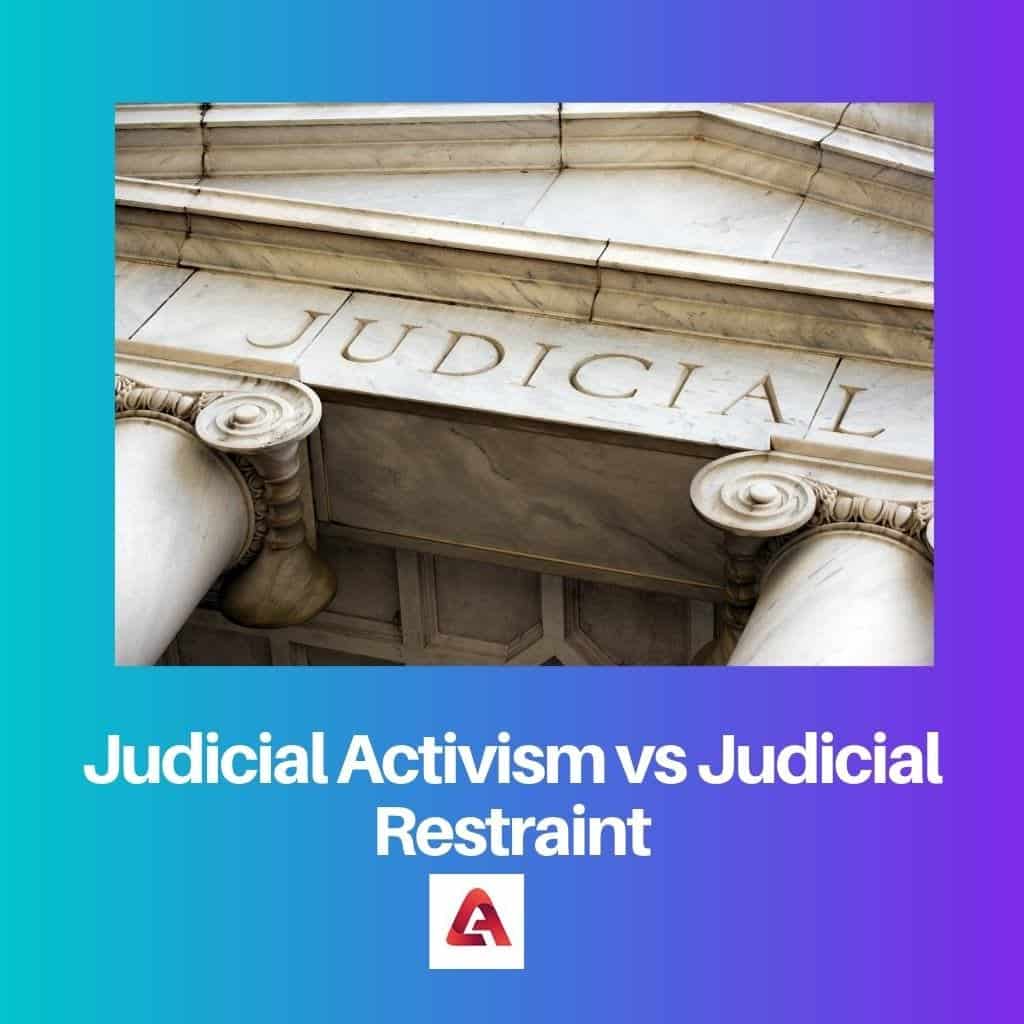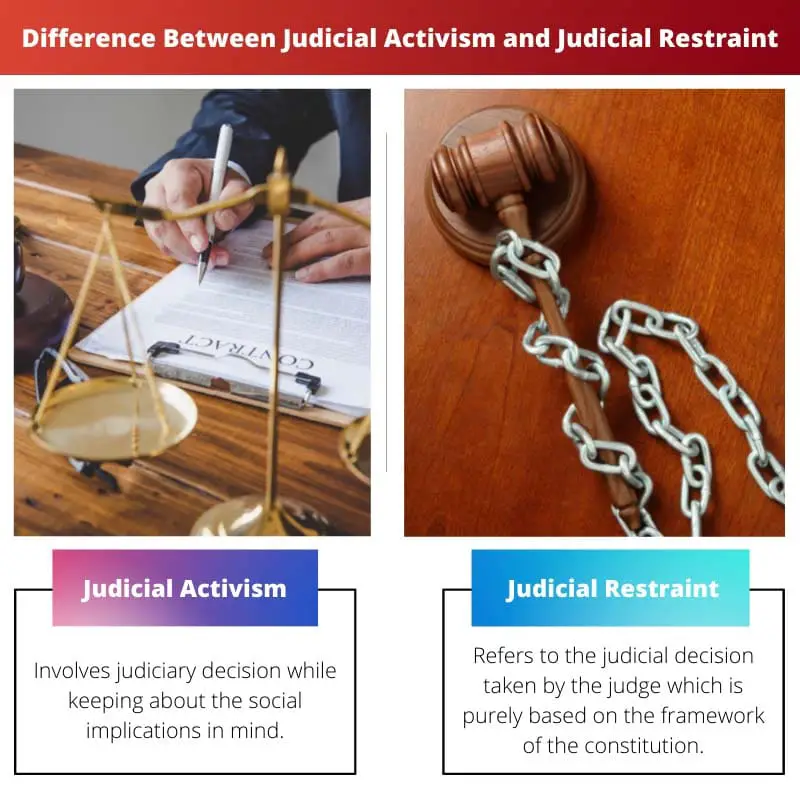Judicial activism involves judges interpreting the Constitution broadly to address societal issues, shaping policy through decisions. In contrast, judicial restraint advocates for a more limited role, emphasizing adherence to the original intent of the Constitution and deferring to legislative and executive branches for policy decisions.
Key Takeaways
- Judicial Activism involves judges interpreting laws to reflect current societal values, while Judicial Restraint involves judges strictly interpreting laws as written.
- Judicial Activism can lead to more progressive social changes, while Judicial Restraint can maintain the status quo.
- Judicial Activism can be controversial, as it can be seen as judges overstepping their bounds, while Judicial Restraint can be seen as judges being too passive.
Judicial Activism vs. Judicial Restraint
Judicial activism is an approach in which judges interpret the law in a way that advances social and political goals, even if those goals are not explicitly stated in the law. Judicial restraint is an approach in which judges limit their interpretation of the law to the specific language of the law itself, and avoid making decisions.

Judicial restraint tries to refrain from interfering in political decisions, but judicial activism does not hesitate to interfere in political decisions.
Comparison Table
| Feature | Judicial Activism | Judicial Restraint |
|---|---|---|
| Approach to interpretation | More expansive interpretation of the Constitution based on evolving values and societal needs. | Emphasizes original intent of the Constitution as written by the Founders. |
| Role of the Judiciary | More active role in shaping public policy and protecting individual rights, even if it means overturning laws or government actions. | More deferential role to the legislative and executive branches, focusing primarily on interpreting the Constitution and laws as written. |
| Examples of decisions | Brown v. Board of Education (1954), Roe v. Wade (1973) | Plessy v. Ferguson (1896), Marbury v. Madison (1803) |
| Strengths | Can be seen as a necessary check on other branches of government and a way to protect individual rights from infringement. | Promotes stability and separation of powers by respecting the decisions of the other branches. |
| Weaknesses | Can be criticized for judicial overreach and for imposing judges’ personal beliefs on society. | Can be accused of failing to protect individual rights and of being out of touch with evolving societal needs. |
What is Judicial Activism?
Judicial activism refers to an approach where judges interpret the law expansively, going beyond the literal text of the Constitution or statutes. This perspective involves judges actively shaping legal precedents to address contemporary societal issues, aiming to achieve broader justice or social goals. Key principles associated with judicial activism include a dynamic interpretation of the Constitution, a focus on evolving social norms, and a willingness to intervene in policy matters.
Broad Constitutional Interpretation
One hallmark of judicial activism is a broad interpretation of constitutional provisions. Activist judges may view the Constitution as a living document, capable of adapting to changing circumstances. This approach contrasts with strict constructionism, which insists on interpreting the Constitution based solely on its original intent. Judicial activists argue for flexibility in interpreting constitutional text to ensure its relevance to contemporary challenges and values.
Addressing Societal Issues
Judicial activists involve themselves in addressing pressing societal issues such as civil rights, environmental protection, and individual liberties. By actively interpreting the law to address these concerns, they contribute to the development of legal precedents that can influence future cases. This proactive role can lead to significant societal change, but critics argue that it may encroach upon the role of the legislative and executive branches in shaping policy.
Criticisms and Controversies
Critics of judicial activism express concerns about potential overreach by judges, contending that it undermines the democratic process. They argue that judges, not being elected officials, should refrain from making policy decisions best left to the elected branches of government. Additionally, opponents argue that activist decisions may reflect the personal biases of judges, raising questions about the legitimacy and impartiality of the judiciary.
Examples of Judicial Activism
Historical examples of judicial activism include cases like Brown v. Board of Education (1954), where the Supreme Court ruled against racial segregation in schools, and Roe v. Wade (1973), which legalized abortion. These decisions illustrate instances where judges actively interpreted constitutional principles to bring about significant societal change.

What is Judicial Restraint?
Judicial restraint is a legal philosophy that emphasizes a cautious and limited role for the judiciary in interpreting and applying the law. This approach is rooted in the belief that judges should exercise restraint in overturning legislative or executive actions and should defer to the decisions of elected representatives when possible.
Adherence to Precedent
One fundamental principle of judicial restraint is a strong commitment to stare decisis, or the precedent. Judges following this philosophy prioritize consistency with past decisions, aiming to maintain stability in the legal system. By adhering to precedent, they seek to avoid abrupt changes in legal interpretations that might result from a more activist approach.
Deference to the Political Branches
Judicial restraint advocates argue for deference to the legislative and executive branches, asserting that elected representatives are better positioned to make policy decisions. This perspective emphasizes the importance of separation of powers, asserting that judges should refrain from engaging in policymaking and instead allow the democratic process to shape laws.
Criticisms and Challenges
While judicial restraint is seen by some as preserving the proper balance of powers, critics argue that it may hinder the judiciary’s ability to address evolving societal issues. Critics assert that an overly restrained approach could result in the perpetuation of unjust laws or insufficient protection of individual rights, as judges might be hesitant to challenge legislative or executive decisions.
Balancing Act: Striking the Right Balance
The debate surrounding judicial restraint centers on finding the right balance between respecting precedent and allowing for legal evolution. Striking this balance requires judges to carefully consider when it is appropriate to defer to past decisions and when intervention is necessary to protect constitutional principles and individual rights.

Main Differences Between Judicial Activism and Judicial Restraint
- Interpretation of the Constitution:
- Activism: Involves a broad and flexible interpretation of the Constitution, adapting to contemporary societal issues.
- Restraint: Emphasizes a strict and narrow interpretation, adhering closely to the original intent of the Constitution.
- Role of the Judiciary:
- Activism: Advocates for an active role of the judiciary in shaping and influencing public policy.
- Restraint: Favors a limited role, with judges deferring to the decisions of the legislative and executive branches, particularly on policy matters.
- Use of Precedent:
- Activism: May be more willing to depart from precedent if societal changes warrant a reinterpretation of legal principles.
- Restraint: Prioritizes adherence to precedent (stare decisis) to maintain legal stability and consistency.
- Deference to Elected Representatives:
- Activism: Less likely to defer to elected representatives, as it may involve judicial intervention to address perceived injustices or protect individual rights.
- Restraint: Emphasizes deference to the decisions of elected officials, viewing them as better suited to make policy choices in a democratic system.
- Evolution of Laws:
- Activism: Supports a more dynamic and evolving legal system, allowing for judicial decisions to reflect changing societal norms.
- Restraint: Tends to resist rapid legal changes, preferring a more cautious approach that avoids judicial overreach and preserves the separation of powers.





